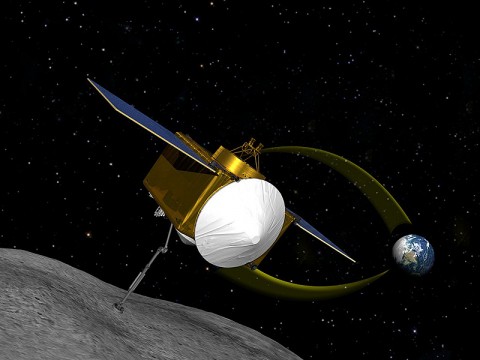 Houston, TX – Scientists at NASA’s Johnson Space Center (JSC) are preparing to curate and analyze samples from the first U.S. mission to return samples from an asteroid.
Houston, TX – Scientists at NASA’s Johnson Space Center (JSC) are preparing to curate and analyze samples from the first U.S. mission to return samples from an asteroid.
The Origins-Spectral Interpretation-Resource Identification-Security-Regolith Explorer, or OSIRIS-REx, was selected by NASA in late May as the third mission in its New Frontiers Program. The robotic spacecraft will launch in 2016 and rendezvous with the near-Earth asteroid 1999 RQ36 in 2020. A robotic arm will collect at least 60 grams of material from the surface of the asteroid to be returned to Earth in 2023 for worldwide distribution by the NASA Astromaterials Curation Facility at JSC.

“Sample return allows us to use the best and most capable instruments here on Earth to unlock the mysteries in these precious samples,” said Lindsay Keller, planetary scientist at JSC and OSIRIS-REx science team member.
JSC scientists Keller, Scott Messenger, Kevin Righter and Keiko Nakamura-Messenger are co-investigators on the mission with Principal Investigator Michael Drake of the University of Arizona in Tucson.
Keller and Nakamura-Messenger will investigate the mineralogy and chemistry of the samples at atomic scales using a state-of-the-art transmission electron microscope. The priority science goals of this study include investigating the effect of solar radiation on asteroidal surfaces, the geological history of the asteroid and the nature and origin of the first solar system solids.
Messenger will study the isotopic properties of the asteroidal samples with a NanoSIMS ion microprobe, a powerful mass spectrometer for measuring microscopic samples. He will determine the age of the samples and study the properties of ancient stardust grains and organic matter that predate the origin of the solar system.
JSC curates seven different types of astromaterials, beginning with the 1969 return of lunar rocks from the Apollo missions and including NASA’s recent Genesis Mission solar wind samples and Stardust mission cometary dust samples. Lessons learned at JSC from participating in these previous extraterrestrial sample return missions benefit sample protection, contingency planning and contamination control knowledge.
“Bringing back samples from an asteroid allows detailed measurements in Earth laboratories that will ultimately lead to a better understanding of connections between asteroids and the thousands of meteorites we have in our collections here on Earth,” said Righter, NASA’s Antarctic meteorite collection curator and OSIRIS-REx curation project lead.
Finally, the curation group will oversee the initial characterization, cataloging and distribution of samples to the science team and a large group of international scientists. In addition to collecting samples, OSIRIS-REx will gather data to help scientists better understand the physical characteristics of potentially hazardous asteroids. Data collected on its surface properties, internal structure and orbital dynamics can be used to help develop hazard mitigation strategies for deflecting asteroids that approach Earth in the future.
1999 RQ36 is also a type of near-Earth asteroid that NASA is considering for human exploration missions as early as 2025. Information that OSIRIS-REx collects from 1999 RQ36 will help formulate the types of operations and identify the mission activities that astronauts will perform during their expeditions to these asteroids. Such information is crucial in preparing for humanity’s next steps beyond low Earth orbit and on to deep space destinations.
For more on the JSC’s Astromaterials Research and Exploration Science Directorate, visit:
http://ares.jsc.nasa.gov


